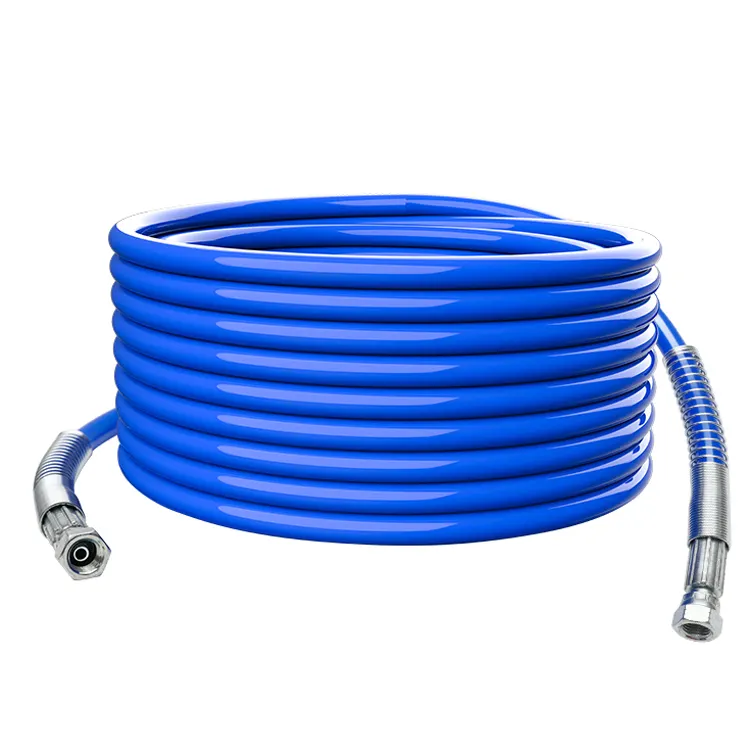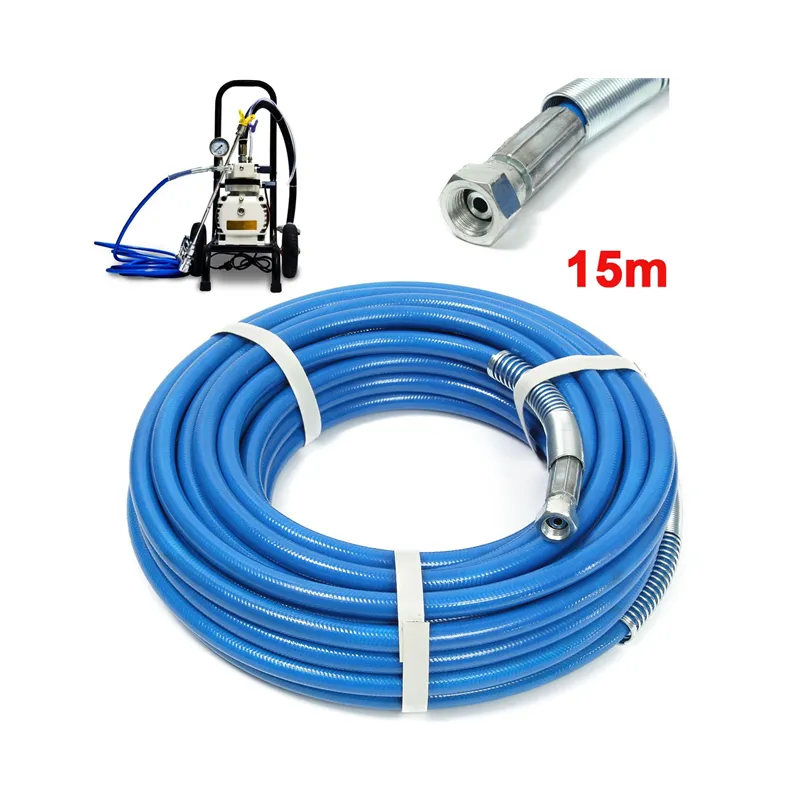Sewer Jetting Hose:
—————————————–Powerful Cleaning for Efficient Drain Maintenance
- Introduction
- What is a Sewer Jetting Hose?
- The Importance of Sewer Jetting
- Types of Sewer Jetting Hoses
- High-Pressure Jetting Hose
- Thermoplastic Jetting Hose
- Steel Braided Jetting Hose
- Features and Benefits of Sewer Jetting Hoses
- Flexibility and Maneuverability
- High Pressure and Flow Rate
- Durability and Longevity
- Compatibility with Various Nozzles and Systems
- Choosing the Right Sewer Jetting Hose
- Consider the Application
- Evaluate Pressure and Flow Requirements
- Assess Hose Length and Diameter
- Examine Material and Construction
- Maintenance and Care for Sewer Jetting Hoses
- Proper Storage
- Regular Inspections
- Cleaning and Drying
- Conclusion
- FAQs
In the world of drain maintenance and sewer cleaning, one tool stands out for its exceptional effectiveness and efficiency—the sewer jetting hose. With its high-pressure water flow, this specialized hose provides a reliable solution for clearing clogs, removing debris, and maintaining the smooth operation of sewer lines. In this article, we’ll explore the features, benefits, and selection considerations of sewer jetting hoses, empowering you with the knowledge to choose the right one for your needs.
What is a Sewer Jetting Hose?
A sewer jetting hose is a specially designed hose used in conjunction with a sewer jetter to perform high-pressure water jetting. It is typically made of durable materials capable of withstanding the demanding conditions of sewer cleaning operations. The hose is connected to a high-pressure water source, such as a jetter machine or truck-mounted jetting system, and it delivers a powerful stream of water to dislodge obstructions and clean sewer lines effectively.

Sewer Jetting Hoses
The Importance of Sewer Jetting
Sewer jetting is a crucial aspect of drain maintenance and pipe cleaning. Over time, debris, grease, roots, and other substances can accumulate inside sewer lines, leading to clogs and reduced flow capacity. Traditional methods like snaking or augering may not fully clear the obstructions or address the underlying issues. That’s where sewer jetting comes in. By utilizing high-pressure water streams, jetting hoses can break up and remove stubborn blockages, restoring the proper functioning of sewer lines and preventing potential backups and overflows.
Types of Sewer Jetting Hoses
There are various types of sewer jetting hoses available, each with its unique characteristics and advantages. Understanding the differences between these types can help you make an informed decision when selecting the most suitable hose for your specific requirements.
1,High-Pressure Jetting Hose
High-pressure jetting hoses are designed to withstand extreme water pressure levels, typically ranging from 2,000 to 10,000 PSI (pounds per square inch). These hoses are constructed with reinforced materials and multiple layers to ensure strength and durability during intense jetting operations. High-pressure jetting hoses are ideal for heavy-duty applications, such as commercial or industrial sewer cleaning.
2,Thermoplastic Jetting Hose
Thermoplastic jetting hoses offer excellent flexibility and maneuverability. They are lightweight, making them easier to handle and transport, while still maintaining high burst strength and pressure ratings. Thermoplastic hoses are resistant to abrasion and chemicals, ensuring a longer lifespan even when subjected to harsh cleaning environments.

Thermoplastic Jetting Hose
4,Steel Braided Jetting Hose
Steel braided jetting hoses combine the strength of steel with the flexibility of thermoplastic materials. These hoses feature a steel wire braid reinforcement, enhancing their durability and resistance to external impacts. Steel braided jetting hoses are well-suited for heavy-duty applications that require both high pressure and added protection against potential damage.
Features and Benefits of Sewer Jetting Hoses
Sewer jetting hoses offer a range of features and benefits that make them indispensable tools for drain-cleaning professionals. Let’s explore some of the key advantages they bring to the table.
1,Flexibility and Maneuverability
Sewer jetting hoses are designed to be highly flexible and maneuverable, allowing operators to navigate through tight bends and narrow sewer lines with ease. The hoses can snake through the pipes, reaching areas that traditional cleaning methods might struggle to access, ensuring a comprehensive cleaning process.
2,High Pressure and Flow Rate
One of the primary advantages of sewer jetting hoses is their ability to deliver high-pressure water streams. The intense water pressure generated by these hoses can effectively break up obstructions, dislodge debris, and flush out accumulated materials within sewer lines. Additionally, the high flow rate ensures thorough cleaning and efficient removal of contaminants.
3,Durability and Longevity
Sewer jetting hoses are subject to harsh conditions during cleaning operations, including exposure to chemicals, abrasive materials, and extreme pressures. To withstand these challenges, these hoses are constructed from durable materials that offer excellent resistance to wear, tear, and degradation. This durability ensures a longer lifespan, reducing the need for frequent hose replacements and saving on maintenance costs.
4,Compatibility with Various Nozzles and Systems
Sewer jetting hoses are compatible with a wide range of nozzles and jetting systems. Different nozzles provide various spray patterns, allowing operators to customize the water flow according to the specific cleaning requirements. Whether it’s removing tree roots or clearing stubborn grease deposits, the versatility of sewer jetting hoses ensures optimal performance in diverse cleaning scenarios.
Choosing the Right Sewer Jetting Hose
Selecting the right sewer jetting hose requires careful consideration of several factors to ensure optimal performance and longevity. Here are some essential aspects to keep in mind when choosing a hose for your drain cleaning needs.
1,Consider the Application
Different sewer cleaning applications may have specific requirements. For instance, residential drain cleaning may demand a different hose than industrial or municipal sewer maintenance. Consider the nature and scale of your cleaning projects to determine the appropriate hose type and specifications.
2,Evaluate Pressure and Flow Requirements
Assess the pressure and flow rate requirements of your cleaning operations. The pressure rating of the hose should match or exceed the capabilities of your jetter system to ensure effective cleaning. Similarly, the flow rate should be sufficient to flush out debris and contaminants without causing damage to the sewer lines.
3,Assess Hose Length and Diameter
The length and diameter of the hose play a crucial role in determining its reach and effectiveness. Measure the distances you need to cover and ensure that the hose length is sufficient to reach the desired locations. Additionally, consider the diameter of the hose, as a larger diameter can provide higher flow rates, but may be less flexible in tight spaces.
4,Examine Material and Construction
Inspect the materials used in the construction of the hose. Look for hoses made from durable and abrasion-resistant materials that can withstand the demanding conditions of sewer cleaning. Consider factors such as burst strength, reinforcement layers, and chemical resistance to ensure the longevity and performance of the hose.
Maintenance and Care for Sewer Jetting Hoses
To maximize the lifespan and performance of your sewer jetting hose, proper maintenance and care are essential. Follow these guidelines to ensure the longevity and reliability of your hose.
1,Proper Storage
After each use, drain the hose of any remaining water and properly coil it for storage. Avoid exposing the hose to extreme temperatures, sunlight, or chemicals that could degrade the materials. Storing the hose in a cool, dry place will help prevent damage and prolong its lifespan.
2,Regular Inspections
Perform regular inspections of your sewer jetting hose to identify any signs of wear, abrasion, or damage. Look for cracks, leaks, or bulges that may compromise the hose’s integrity. Replace any damaged hoses promptly to prevent further issues and ensure safe and efficient operation.
3,Cleaning and Drying
Clean the hose thoroughly after each use to remove any debris or contaminants. Flushing the hose with clean water can help remove any residue or buildup that may affect its performance. Additionally, ensure the hose is completely dry before storing it to prevent the growth of mold or mildew.
Conclusion
Sewer jetting hoses are essential tools for efficient and thorough drain maintenance. Their high-pressure water flow, durability, and flexibility make them ideal for clearing clogs, removing debris, and ensuring the smooth operation of sewer lines. By understanding the different types of sewer jetting hoses and considering factors such as pressure requirements, hose length, and maintenance, you can make an informed choice when selecting the right hose for your needs. Invest in a quality sewer jetting hose, and experience the power and efficiency it brings to your drain cleaning operations.
Q1: How often should I inspect my sewer jetting hose?
It is recommended to inspect your sewer jetting hose before and after each use. Regular inspections can help identify any signs of wear or damage, allowing for timely repairs or replacements.
Q2: Can I use any nozzle with a sewer jetting hose?
Sewer jetting hoses are compatible with various nozzles. Different nozzles offer different spray patterns and functions, allowing you to customize the water flow according to your specific cleaning requirements.
Q3: What is the maximum pressure rating of sewer jetting hoses?
The maximum pressure rating can vary depending on the type and brand of the hose. Some sewer jetting hoses can handle pressures ranging from 2,000 to 10,000 PSI or even higher.
Q4: Can I use a sewer jetting hose for other applications besides drain cleaning?
While sewer jetting hoses are primarily designed for drain cleaning, they can also be used in other applications that require high-pressure water flow, such as surface cleaning, hydro excavation, or descaling pipes.
Q5: How long can a sewer jetting hose last?
The lifespan of a sewer jetting hose depends on various factors, including usage frequency, maintenance, and the quality of the hose itself. With proper care and maintenance, a high-quality sewer jetting hose can last for several years.

 sunhose
sunhose sunhose
sunhose